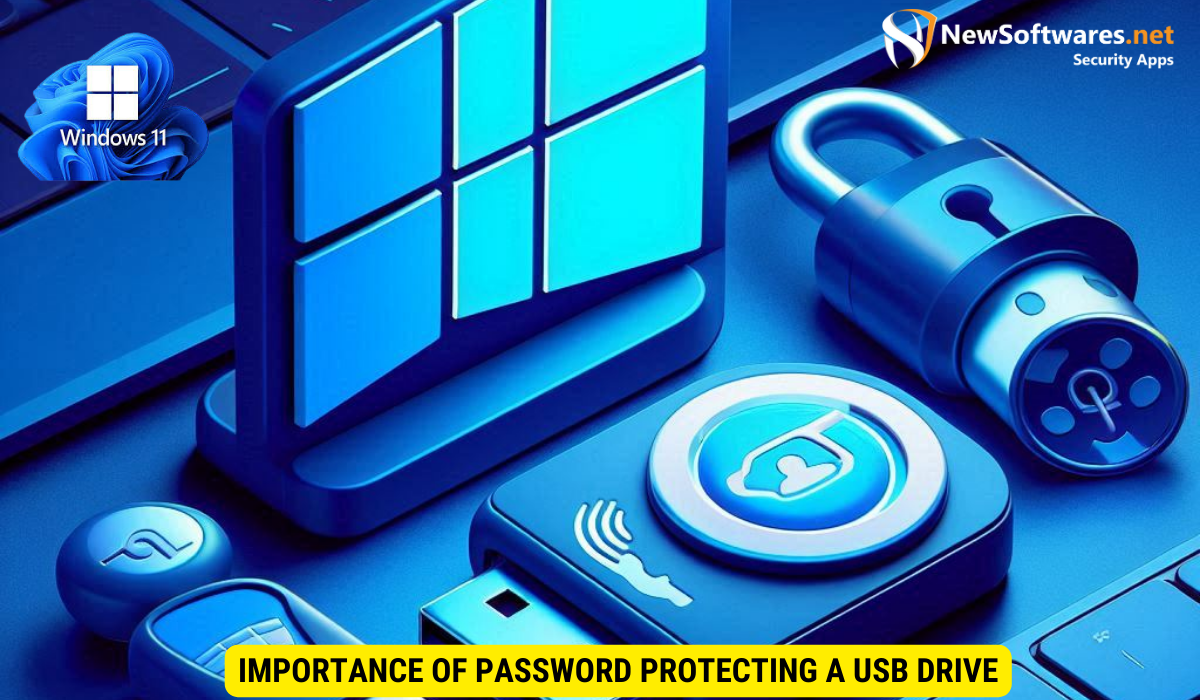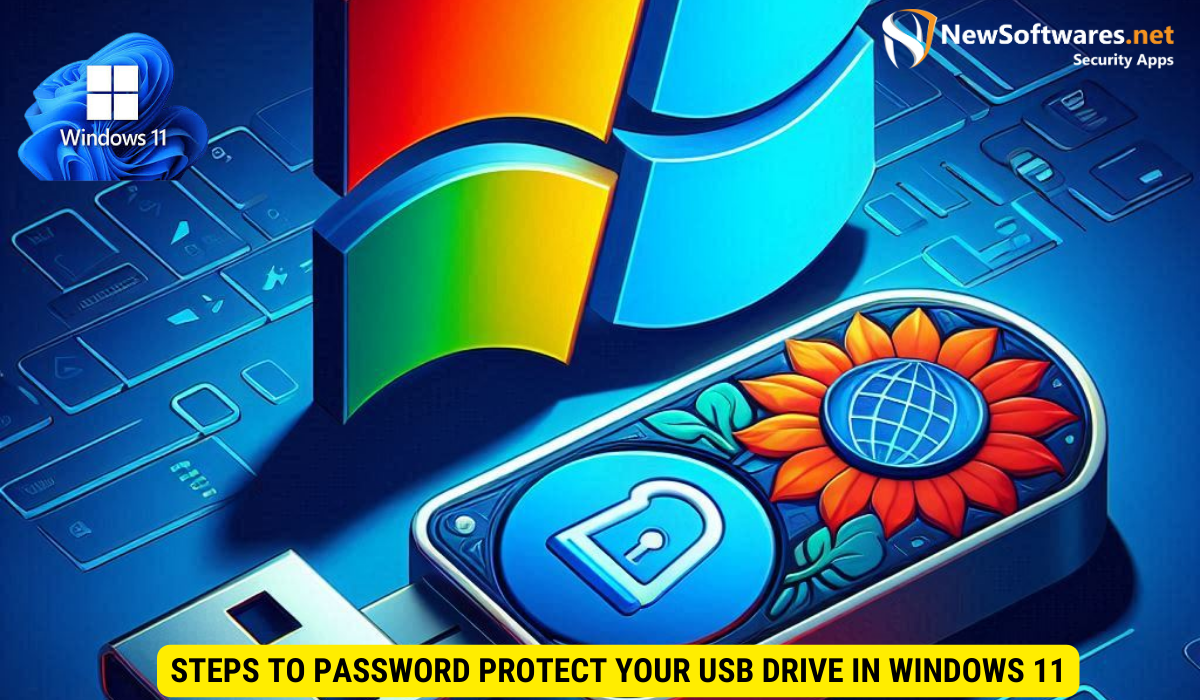To password protect a USB drive in Windows 11 :
- Insert the USB drive and open File Explorer.
- Right-click the USB drive and select Properties.
- Go to the Security tab and click on BitLocker.
- Choose “Use a password to unlock the drive.”
- Enter and confirm your password.
- Back up your recovery key.
- Select the encryption options.
- Click “Start encrypting” to begin.
Protecting your USB drive with a password is an essential step in safeguarding your sensitive data. With the increasing risks of data breaches and cyber threats, it is crucial to take proactive measures to ensure the security of your USB drive. I will guide you through the process of password protecting your USB drive in Windows 11.
Importance of Password Protecting a USB Drive

Your USB drive contains valuable information that you want to keep private and secure. By password protecting your USB drive, you add an extra layer of defense against unauthorized access and potential data leaks. Let’s explore the risks of leaving your USB drive unprotected and the benefits of taking the necessary precautions.
When it comes to the risks associated with leaving your USB drive unprotected, it’s crucial to consider the potential consequences. Not only can unauthorized access lead to the exposure of sensitive information such as personal documents, financial records, or business files, but it can also result in identity theft or financial loss. Moreover, the proliferation of malware and viruses in today’s digital landscape means that connecting an unprotected USB drive to your computer poses a significant threat to the security of your data and system.
The Risks of Unprotected USB Drives
Leaving your USB drive unprotected poses significant risks to the confidentiality and integrity of your data. If your USB drive falls into the wrong hands, sensitive information such as personal documents, financial records, or business files can be accessed and misused. Additionally, malware or viruses can be inadvertently transferred to your computer when connecting an unprotected USB drive.
Furthermore, the potential impact of a data breach resulting from an unprotected USB drive cannot be understated. From tarnished reputations to legal ramifications, the fallout from a security incident can be far-reaching and long-lasting. Taking proactive steps to secure your USB drive through password protection is essential in safeguarding not only your data but also your peace of mind.
Benefits of Password Protecting Your USB Drive
By password protecting your USB drive, you ensure that only authorized individuals can access its content. This prevents unauthorized users from accessing your data and helps maintain your privacy. Password protection adds an extra layer of security, giving you peace of mind, especially when you need to transport sensitive information.
Moreover, password protecting your USB drive empowers you to control who can view, copy, or modify the data stored on it. Whether you’re a student safeguarding your academic projects or a professional protecting confidential work documents, implementing password protection is a proactive measure that can mitigate the risks associated with data breaches and unauthorized access. Additionally, in the event that your USB drive is lost or stolen, password protection serves as a critical barrier, reducing the likelihood of unauthorized individuals exploiting your data.
Preparing Your USB Drive for Password Protection
Before you begin the password protection process, there are a few important steps you should take to ensure a smooth experience.
Checking Your USB Drive’s Compatibility
Not all USB drives support password protection. It is essential to check if your USB drive is compatible with the built-in encryption feature in Windows 11. Refer to the manufacturer’s documentation or the official website to verify compatibility.
Backing Up Your USB Drive
Prior to enabling password protection, make sure to back up all the data on your USB drive. This ensures that you have a copy of your files in case anything goes wrong during the encryption process.
Steps to Password Protect Your USB Drive in Windows 11

Now that you have prepared your USB drive, let’s dive into the process of password protecting it in Windows 11.
Accessing the BitLocker Drive Encryption
The BitLocker Drive Encryption is a built-in tool in Windows 11 that allows you to encrypt and password protect your USB drive. To access it, follow these steps:
- Connect your USB drive to your Windows 11 computer.
- Open the File Explorer by clicking on the folder icon in the taskbar.
- Locate your USB drive in the list of available drives.
- Right-click on your USB drive and select “Turn on BitLocker.”
- If prompted, enter your admin credentials to continue.
Setting Up a Password for Your USB Drive
Now that you have accessed the BitLocker Drive Encryption, it’s time to set up a password for your USB drive:
- Select the “Use a password to unlock the drive” option.
- Create a strong password that includes a combination of uppercase and lowercase letters, numbers, and special characters. Remember to choose a password that is easy for you to remember but difficult for others to guess.
- Re-enter the password to confirm it.
- Click “Next” to proceed.
Completing the Encryption Process
Once you have set up a password for your USB drive, the encryption process will begin. This process may take some time, depending on the size of your USB drive. It is important not to interrupt the process to avoid data corruption. Once the encryption is complete, your USB drive will be protected with the entered password.
Troubleshooting Common Issues
While password protecting your USB drive is relatively straightforward, you may encounter some common issues during the process. Here are a few troubleshooting steps to help you overcome them.
What to Do If BitLocker is Not Available
If your version of Windows 11 does not include the BitLocker feature, you may need to upgrade to a higher edition or consider using third-party encryption software. Research reputable encryption software alternatives and follow their respective instructions to password protect your USB drive.
Recovering a Forgotten Password
If you forget the password for your encrypted USB drive, it can be challenging to recover your data. It is advisable to keep a record of your passwords in a secure location or use a reliable password management tool to avoid such situations. If you forget the password, you may need to format the USB drive, resulting in the loss of all data stored on it.
Maintaining Your Password Protected USB Drive
Now that you have successfully password protected your USB drive, it is important to maintain its security over time.
Changing Your Password Regularly
To enhance the security of your USB drive, consider changing the password periodically. This is particularly important if you suspect someone may have accessed your password or if you have shared your USB drive’s password with someone whom you no longer trust.
Safely Removing Your USB Drive from the Computer
Always remember to eject your USB drive safely from your computer before physically removing it. This ensures that all data is saved and any ongoing encryption processes are completed. Simply right-click on your USB drive in the File Explorer and select “Eject” or “Safely Remove Hardware” before removing the USB drive.
Key Takeaways
- Password protecting your USB drive adds an extra layer of security and safeguards your sensitive data.
- Before password protecting your USB drive, check its compatibility and back up your data.
- Windows 11 provides the BitLocker Drive Encryption tool for password protecting your USB drive.
- During the process, set up a strong password and ensure you do not interrupt the encryption process.
- Maintain the security of your password protected USB drive by changing your password regularly and safely ejecting the drive from your computer.
FAQs
1. How do I know if my USB drive is compatible with password protection in Windows 11?
You can check the compatibility of your USB drive by referring to the manufacturer’s documentation or visiting their official website. They should provide information on whether the USB drive supports encryption features like BitLocker in Windows 11.
2. Can I recover my data if I forget the password for my encrypted USB drive?
Unfortunately, forgetting the password for your encrypted USB drive can make it extremely difficult, if not impossible, to recover the data. It is essential to keep a record of your passwords in a secure location or use a reliable password management tool to avoid such situations.
3. Are there any alternative encryption software options if BitLocker is not available in my version of Windows 11?
If your version of Windows 11 does not include the BitLocker feature, you can explore alternative encryption software options. Research reputable third-party encryption software and follow their instructions to password protect your USB drive.
4. Can I use the same password for multiple USB drives?
While using the same password for multiple USB drives may seem convenient, it is not recommended. Each USB drive should have a unique password for enhanced security. If one USB drive’s password is compromised, it ensures that the other drives remain protected.
5. Is it possible to recover my data if I format my password-protected USB drive?
No, formatting your password-protected USB drive will erase all the data stored on it, and there is no way to recover the lost data. It is crucial to create regular backups of your important files to prevent any critical data loss.
Conclusion
Password protecting your USB drive in Windows 11 is a crucial step in ensuring the security and privacy of your sensitive data. By following the steps provided above, you can easily enable password protection using the BitLocker Drive Encryption tool. Remember to regularly change your password and safely remove your USB drive from the computer to maintain its security over time.
